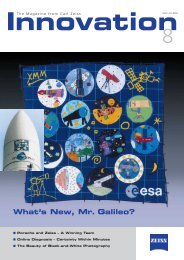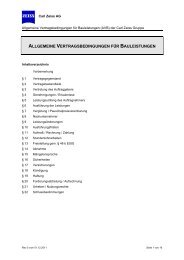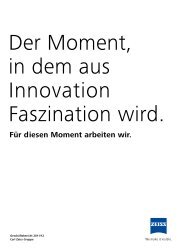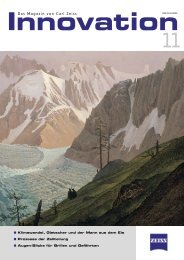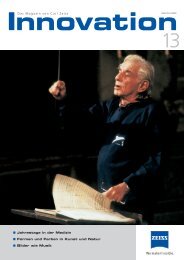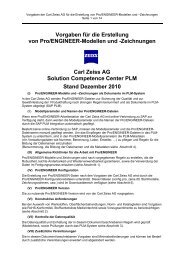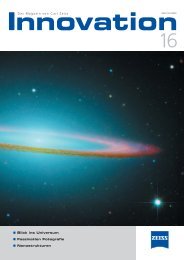Download PDF - Carl Zeiss
Download PDF - Carl Zeiss
Download PDF - Carl Zeiss
Create successful ePaper yourself
Turn your PDF publications into a flip-book with our unique Google optimized e-Paper software.
Fascinated by Photography<br />
The word “photography” was<br />
used for the first time in 1839<br />
by German astronomer Johann<br />
Heinrich Mädler (1794-1874) and,<br />
at about the same time, by<br />
British astronomer John Frederick<br />
William Herschel (1792-1871).<br />
The instrument used before the rise<br />
of photography was the “camera<br />
obscura”, from which the term<br />
“camera” takes its name. The first<br />
photograph was taken in 1826 by<br />
Joseph Nicéphore Niépce. Two inventors<br />
enabled the decisive breakthrough<br />
in the first half of the 19 th<br />
century. Frenchman Louis Jacques<br />
Mandé Daguerre (1787-1851) based<br />
his photographic technique, called<br />
Innovation 16, <strong>Carl</strong> <strong>Zeiss</strong> AG, 2005<br />
daguerreotype, on the experience<br />
provided by Joseph Nicéphore<br />
Niépce. English physicist and chemist<br />
William Henry Fox Talbot (1800-<br />
1877) is considered the founder of<br />
the negative-positive process termed<br />
Talbotype that was patented in 1841<br />
and which made photographic imaging<br />
reproducible almost without limits.<br />
The first wooden daguerrotype<br />
cameras were sold by Alphonse<br />
Giroux, a camera manufacturer in<br />
Paris.<br />
We are not only filled with enthusiasm<br />
by the latest photos of the cosmos,<br />
but have always been interested<br />
in pictures of nature and art. A wide<br />
spectrum of design options is available<br />
to the photographer depending<br />
on the applied technique – camera,<br />
film format and material, lens, reprocessing.<br />
The Distagon ® T* 4/40 IF CFE<br />
lens is ideal for demanding architecture,<br />
object and industry photography<br />
as well as for cityscapes.<br />
With its image angle of 88° across<br />
the field diagonal, this is the classic<br />
wide-angle lens for medium-format<br />
cameras. Floating elements helped<br />
reduce the unavoidable field curvature<br />
in close-ups. Its remarkably good<br />
optical correction, especially the good<br />
distortion correction, makes this lens<br />
the ideal tool for architectural, object<br />
and industrial photography. It is also<br />
ideal for aerial photography, as photos<br />
can be taken from low altitudes<br />
where the adverse effects of atmospheric<br />
interference, e.g. haze, are<br />
reduced. NASA also is a satisfied user<br />
of more than 30 lenses.<br />
Photography<br />
37




